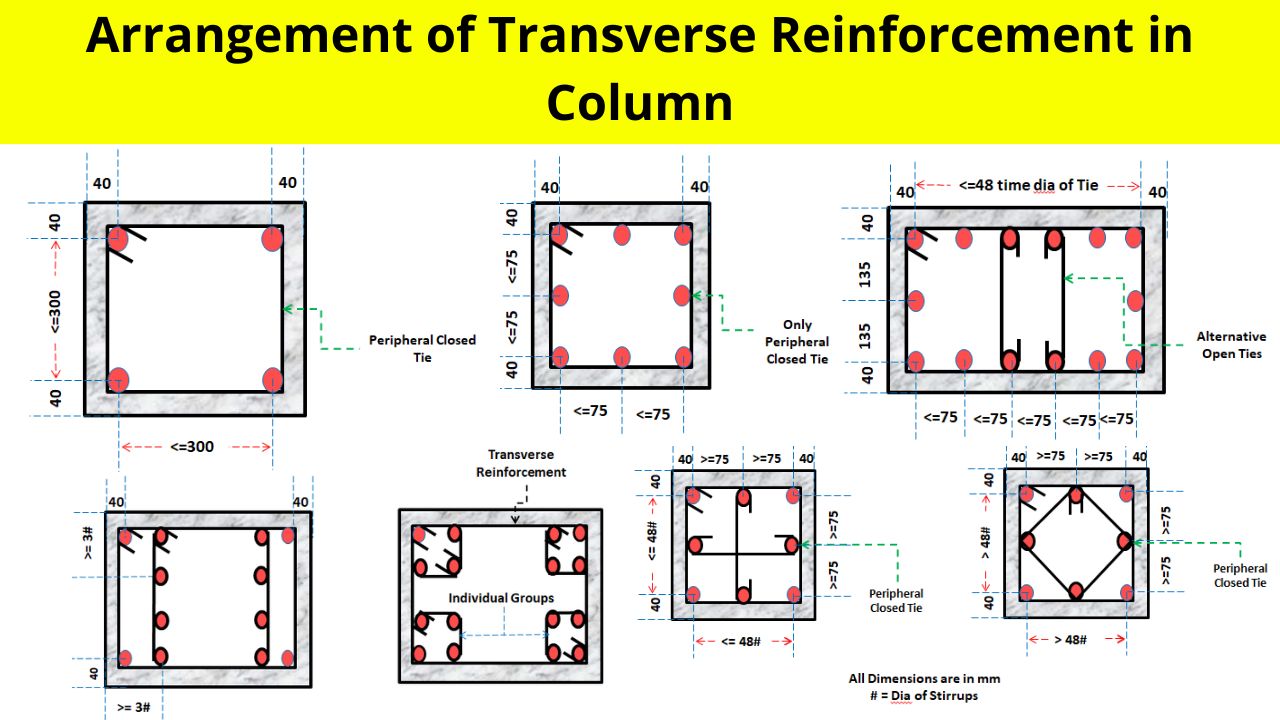In this article, we explained the various criteria for arrangement of transverse reinforcement in column, Spacing criteria between Longitudinal bar and ties. How to decide the shape and legs of ties as per Nos of longitudinal bars in column, etc.
So, Pleas read this article till the end, if you obtain any knowledge from this article please recommend it with your friends which motivate us to create more article like this. Let’s start.
Table of Contents
Arrangement of Transverse Reinforcement in Column
Maximum of you know, What is Transverse reinforcement? and Why it is provided? But few of you are not have better understanding about Transverse Reinforcement and its purpose. That’s why first I cleared the meaning of transverse reinforcement and purpose of it with short description.
What is Transverse Reinforcement in Column
Transverse reinforcements are the horizontal reinforcement in the shape of polygon or circular to resist the Circumferential tension or Shear Force into the Column. In column, Transverse reinforcement are also known as Tie, ring or link.
Ties are also used to hold the position of longitudinal reinforcement and provide support to overcome buckling of longitudinal bars.
Also Read: What is Pedestal in Column Footing
Criteria for Arrangement of Transverse Reinforcement in Column
IS 456 Recommended few criteria for arrangement of transverse reinforcement which are mentioned here as below.
1. If there are four longitudinal bars in column, a peripheral closed tie is required to provide enough lateral support to each longitudinal bar in both direction against buckling.

Do You Know : 5 Best Structural Design and Analysis Software
2. When there are more than two longitudinal bars on a given face of column, If the spacing between longitudinal bars not exceeding 75mm, Only alternate longitudinal bars need support in other direction by open ties.

Also Read: What is Flexural Strength of Concrete
3. When spacing of longitudinal bars on a given face of column is more than 75mm, All internal longitudinal bars shall be tied with additional ties which may be open or closed tie as shown in figure.

Do You Know: Development length of bar in Beam
4. If the longitudinal bars spaced at distance of not exceeding 48 times diameter of the tie are effectively tied in two directions, additional longitudinal bars in between these bars need to be tied in one direction by open ties. This implies that if the longitudinal bars are spaced at a distance of more than 48 time dia of ties than closed ties for internal bars will be required and may be arranged as shown in figure.

Also Read: What is Expansion joint in building
5. If the longitudinal bars of column are placed in more than one row than the transverse reinforcement should be accordance with the above criteria. And the inner row longitudinal bars are spaced more than three (3) times the the diameter of the largest bar of inner row from nearest compression face.

Do You Know: Ductile Detailing of Beam as per IS 13920-2016
6. Where the longitudinal bars are grouped (not in contact) and each group adequately tied with transverse reinforcement in accordance with above requirements, the transverse reinforcement for the section as a whole may be provided on the assumption that each group is a single longitudinal bar for purpose of determining the pitch and diameter of the transverse reinforcement in accordance with above requirements. The diameter of such transverse reinforcement need not, However, exceed 20mm.

Do You Know: Why Doubly Reinforced Concrete Beam is less Economical?

